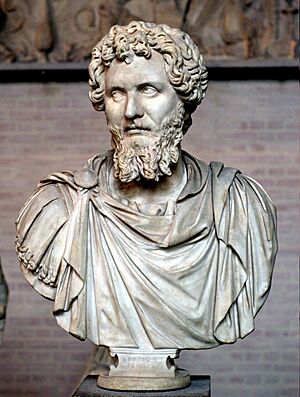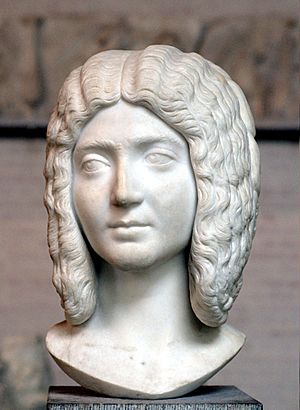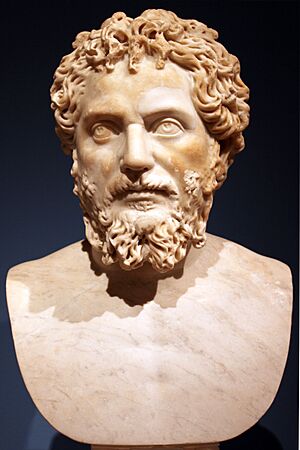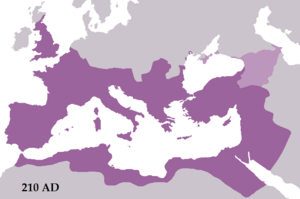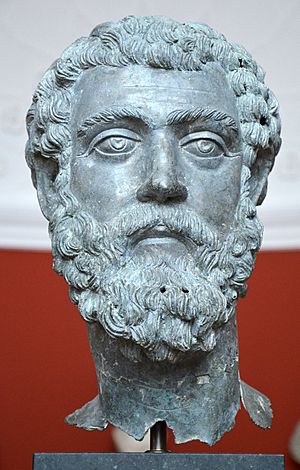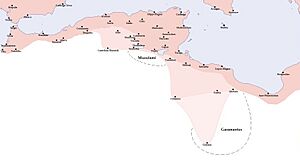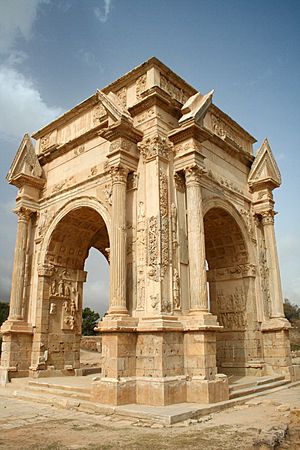Septimius Severus facts for kids
Quick facts for kids Septimius Severus |
|||||
|---|---|---|---|---|---|
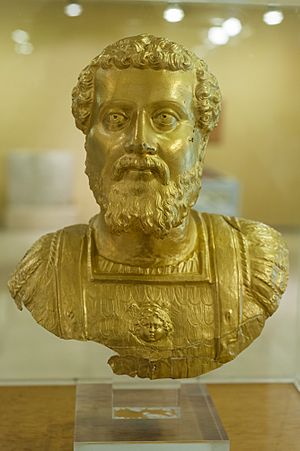
Gold bust of Septimius Severus found in 1965 at Didymoteicho in Northern Greece, now at the Archaeological Museum of Komotini
|
|||||
| Roman emperor | |||||
| Reign | 9 April 193 – 4 February 211 |
||||
| Predecessor | Didius Julianus | ||||
| Successors | Caracalla and Geta | ||||
| Co-emperors |
|
||||
| Born | Lucius Septimius Severus 11 April 145 Leptis Magna, Africa |
||||
| Died | 4 February 211 (aged 65) Eboracum, Britain |
||||
| Spouse |
|
||||
| Issue | Caracalla and Geta | ||||
|
|||||
| Dynasty | Severan | ||||
| Father | Publius Septimius Geta | ||||
| Mother | Fulvia Pia | ||||
Lucius Septimius Severus (born 11 April 145 – died 4 February 211) was a powerful Roman emperor who ruled from 193 to 211 AD. He was born in Leptis Magna (which is now Al-Khums, Libya), a Roman province in Africa. He was the first Roman emperor who was not from Italy.
As a young man, Severus worked his way up through the usual government jobs under emperors Marcus Aurelius and Commodus. He took control after Emperor Pertinax was killed in 193. This period was known as the "Year of the Five Emperors" because many people tried to become emperor.
After removing and killing the current emperor Didius Julianus, Severus fought against other generals who wanted to be emperor. These were Pescennius Niger and Clodius Albinus. Severus won against Niger in 194 and against Albinus in 197. After securing his power in the west, Severus fought a successful war against the Parthian Empire in the east. He captured their capital city, Ctesiphon, in 197. He also made the Roman Empire's borders bigger in the east and south.
Severus made his older son, Caracalla, a co-emperor in 198. His younger son, Geta, became a co-emperor in 209. Both were sons of his second wife, Julia Domna. In 208, Severus went to Britain. He made Hadrian's Wall stronger and took back control of the Antonine Wall. He invaded Caledonia (modern Scotland) in 209 with a large army. However, he became very ill and died in early 211 in Eboracum (now York, England). His sons took over, guided by their mother, Julia Domna. This began the Severan dynasty, which was the last ruling family before a difficult period for the Roman Empire.
Contents
Early Life of Septimius Severus
Family and Education
Septimius Severus was born on April 11, 145, in Leptis Magna (modern-day Libya). His father was Publius Septimius Geta, and his mother was Fulvia Pia. His family was wealthy and important. Severus had both Roman and Punic (North African) family roots. Because his father's family was from a province, he is known as the first Roman emperor who was not born in Italy.
Severus had an older brother, Publius Septimius Geta, and a younger sister, Septimia Octavilla. He grew up in Leptis Magna. He could speak the local Punic language very well. He also learned Latin and Greek, though he spoke them with a slight accent. He was very eager to learn. At 17, he gave his first public speech.
Early Career in Rome
Around 162, Severus moved to Rome to start a public career. Emperor Marcus Aurelius helped him join the group of senators. Being a senator was necessary to get important government jobs. His career had some challenges at first. He served in minor roles and faced delays due to a widespread illness called the Antonine Plague.
In 169, Severus became a quaestor, which was an important financial role. This officially made him a member of the Roman Senate. During the 170s, he held many different positions quickly. This was partly because the plague had reduced the number of experienced senators.
Marriages and Family
Around 175, Septimius Severus married Paccia Marciana, a woman from his hometown of Leptis Magna. They were married for over ten years, but they did not have any children who survived. Marciana died around 186.
Severus, now in his forties, wanted to remarry and have children. He heard about a woman in Syria named Julia Domna who was predicted to marry a king. Julia Domna came from an important family in Syria. Her father was a high priest of a local sun god.
Severus and Julia Domna married in 187 in Lugdunum (modern-day Lyon, France), where Severus was governor. Their marriage was happy. Severus valued Julia's intelligence and her political advice. Julia was known for her interest in books and philosophy. They had two sons: Lucius Septimius Bassianus (later called Caracalla), born in 188, and Publius Septimius Geta, born in 189.
Rise to Power
In 191, Emperor Commodus made Severus the governor of a region called Pannonia Superior. The next year, Commodus was killed. Then, Pertinax became emperor, but he was also killed by the Praetorian Guard (the emperor's personal bodyguards) in early 193.
After Pertinax's death, Severus's army declared him emperor. Other armies nearby quickly supported him. Severus quickly marched his army to Italy. The new emperor in Rome, Didius Julianus, had bought the emperorship in an auction. The Roman Senate sentenced Julianus to death, and he was killed. Severus entered Rome without a fight. He punished those who killed Pertinax and replaced the Praetorian Guard with soldiers loyal to him.
However, two other generals, Pescennius Niger in Syria and Clodius Albinus in Britain, also claimed to be emperor. Severus first dealt with Niger, defeating his forces in 194. After a short stay in Rome, Severus went north to face Albinus. In 197, Severus defeated and killed Clodius Albinus at the Battle of Lugdunum. This victory gave Severus complete control over the entire Roman Empire.
Septimius Severus as Emperor
Wars and Border Expansion
In 197, Severus traveled east to fight the Parthian Empire. His armies captured the Parthian capital city of Ctesiphon. He added the northern part of Mesopotamia to the Roman Empire. Severus took the title Parthicus Maximus to celebrate his victory. He also made the Roman borders stronger in the Arabian Desert.
In 202, Severus led a military campaign in Africa and Mauretania against the Garamantes tribes. His general captured their capital city, Garama. This greatly expanded and strengthened the southern border of Roman Africa. The desert tribes could no longer easily raid the Roman lands.
Relations with the Senate and People
Severus did not have a good relationship with the Roman Senate. They did not like him because he took power with the help of the army. He, in turn, did not trust many senators. He removed many senators from their positions and replaced them with people he trusted.
However, Severus was popular with the ordinary people of Rome. He stopped much of the corruption that had happened during the rule of Emperor Commodus. After his victory over the Parthians, he built the Arch of Septimius Severus in Rome to celebrate.
After 197, Severus relied heavily on his wife, Julia Domna, for advice on running the empire. Julia Domna was a very smart and educated woman.
Military Changes
When Severus arrived in Rome in 193, he removed the old Praetorian Guard because they had killed Pertinax and sold the emperorship. He replaced them with 10 new groups of soldiers from his own loyal armies.
Around 197, he increased the number of Roman legions (large army units) from 30 to 33. He also gave his soldiers a bonus and raised their yearly pay. Severus was the first Roman emperor to keep a part of the imperial army in Italy. He understood that Rome needed a central army reserve that could be sent anywhere quickly.
Christians in the Empire
During Severus's rule, the Roman policy towards Christians was still in place: Christians were only punished if they refused to worship the emperor and the Roman gods. They were not actively sought out. So, punishment was not always the same everywhere. Some historians say that Severus might have made a rule against converting to Judaism and Christianity. However, other sources say that Severus was kind to Christians and even had a Christian doctor. Many persecutions of Christians happened during his reign, but these were likely local events rather than empire-wide orders from Severus himself.
Military Activity in Britain
In 208, Severus traveled to Britain because he wanted to conquer Caledonia (modern Scotland). He arrived with a very large army, possibly over 40,000 soldiers.
He made Hadrian's Wall stronger and took back control of the Southern Uplands up to the Antonine Wall, which he also improved. Severus built a huge army camp south of the Antonine Wall. With support from his navy, Severus then led his army north into Caledonian territory. He rebuilt and placed soldiers in many old Roman forts along the east coast.
By 210, Severus's campaign had made good progress, even though the Caledonians used guerrilla tactics. The Caledonians asked for peace, and Severus agreed, but only if they gave up control of the Central Lowlands. However, the Caledonians revolted again later that year. Severus prepared for another long fight, intending to completely defeat them.
Death of Septimius Severus
Severus's campaign in Caledonia was cut short when he became very ill. He went back to Eboracum (York) and died there in 211. His son Caracalla continued fighting for a short time but soon made peace. The Romans never again marched deep into Caledonia. Soon after, the Roman border in Britain was moved permanently back to Hadrian's Wall.
Before he died on February 4, 211, Severus famously told his sons: "Be in harmony, enrich the soldiers, scorn all others." After his death, the Senate declared Severus a god. His sons, Caracalla and Geta, became emperors. They were advised by their mother, Julia Domna. Severus was buried in the Mausoleum of Hadrian in Rome.
Legacy of Septimius Severus
By the end of his rule, the Roman Empire reached its largest size ever, covering over 2 million square kilometers.
Some historians, like Edward Gibbon, believed that Severus played a part in the Roman Empire's decline. They said that while people at the time enjoyed the peace and glory of his rule, his actions had negative effects later on.
Severus made the Limes Tripolitanus stronger, which protected Africa, an important farming region. His victory over the Parthian Empire was also very important for a long time. However, his policy of having a larger and better-paid army was criticized. This was because the Roman people had to pay more taxes to support the army. This increase in military spending caused problems for future emperors.
To pay for his larger army, Severus also reduced the amount of silver in Roman coins. This made the money less valuable and caused problems for the economy in the long run.
Severus was also known for his building projects. He built a large triumphal arch in the Roman Forum in Rome. He also improved his hometown of Leptis Magna, building another triumphal arch there.
Severan dynasty family tree
|
|||||||||||||||||||||||||||||||||||||||||||||||||||||||||||||||||||||||||||||||||||||||||||||||||||||||||||||||||||||||||||||||||||||||||||||||||||||||||||||||||||||||||||||||||||||||||||||||||||||||||||||||||||||||||||||||||||||||||||||||||||||||||||||||||||||||||||||||||||||||||||||||||||||||||||||||||||||||||||||||||||||||||||||||||||||||||||||||||||||||||||||||||||||||||||||||||||||||||||||||||||||||||||||||||||||||||||||||||||||||||||||||||||||||||||||||||||||||||||||||||||||||||||||||||||||||||||||||||||||||||||||||||||||||||||||||||||||||||||||||||||||||||||||||||||||||||||||||||||||||||||||||||||||||||||||||||||||||||||||||||||||||||||||||||||||||||||||||||||||||||||||||||||||||||||||||||||||||||||||||||||||||||||||||||||||||||||||||||||||||||||||||||||||||||||||||||||||||||||||||||||||||||||||||||||||||||||||||||||||||||||||||||||||||||||||||||||||||||||||||||||||||||||||||||||||||||||||||||||||||||||||||||||||||||||||||||||||||||||||||
Notes:
Bibliography:
|
|||||||||||||||||||||||||||||||||||||||||||||||||||||||||||||||||||||||||||||||||||||||||||||||||||||||||||||||||||||||||||||||||||||||||||||||||||||||||||||||||||||||||||||||||||||||||||||||||||||||||||||||||||||||||||||||||||||||||||||||||||||||||||||||||||||||||||||||||||||||||||||||||||||||||||||||||||||||||||||||||||||||||||||||||||||||||||||||||||||||||||||||||||||||||||||||||||||||||||||||||||||||||||||||||||||||||||||||||||||||||||||||||||||||||||||||||||||||||||||||||||||||||||||||||||||||||||||||||||||||||||||||||||||||||||||||||||||||||||||||||||||||||||||||||||||||||||||||||||||||||||||||||||||||||||||||||||||||||||||||||||||||||||||||||||||||||||||||||||||||||||||||||||||||||||||||||||||||||||||||||||||||||||||||||||||||||||||||||||||||||||||||||||||||||||||||||||||||||||||||||||||||||||||||||||||||||||||||||||||||||||||||||||||||||||||||||||||||||||||||||||||||||||||||||||||||||||||||||||||||||||||||||||||||||||||||||||||||||||||||
See also
 In Spanish: Septimio Severo para niños
In Spanish: Septimio Severo para niños
- Bulla Felix
- Septimia gens
- Arcus Argentariorum dedicated by the money changers of Rome to the Severan family.
Images for kids
-
Dynastic aureus of Septimius Severus, minted in 202. The reverse feature the portraits of Geta (right), Julia Domna (centre) and Caracalla (left).
-
Aureus minted in 193 by Septimius Severus to celebrate XIIII Gemina Martia Victrix, the legion that proclaimed him emperor.
-
Kushan ring with portraits of Septimius Severus and Julia Domna, a testimony to Indo-Roman relations of the period


